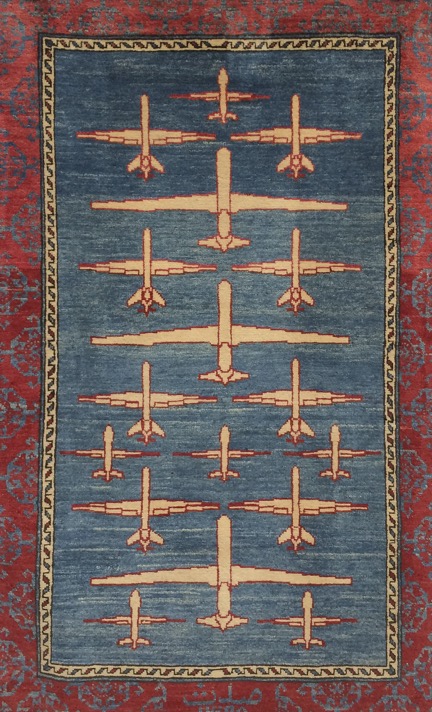Art Combats War
“Reaper and Predator Drone Imagery on Blue Abrash Ground,” Afghanistan, 2016. Wool. Collection of Kevin Sudeith. Photo: Gund Gallery.
December 4, 2022
On Thursday, December 1 in the Barnett Theatre at the Greenhill Center of the Arts, Crossman Gallery Director Ashley Dimmig spoke about art created in the Islamic world that reflects on the violence and loss as a result of war. With two masters degrees and a PhD in the History of Art, she shared insight on the effects of violence by ISIS and Al-Qaeda on the world as displayed through art relating to the UWW production “Grounded” about a female soldier’s experience in the Air Force after an unplanned pregnancy.
How did you get this opportunity to speak at this event?
Bruce Cohen, the director of the performance Grounded, invited me to speak after hearing about my expertise in art of the Islamic world. We both hope that this interdepartmental event will spur future collaborations as well. The event was good – the audience was small but very engaged. I was able to stay after to watch the performance of Grounded, which I thought was very moving.
What is the main idea and focus of this event?
I presented on many examples of the various roles of art vis-à-vis war, including examples of art being used in protests and to forward social justice, projects and exhibitions that aimed to recover art lost in war or deliberately destroyed by groups like the Taliban and ISIS, as well as art that commodifies the effects of war. An example of the latter is the group of woven carpets known as “Afghan War Rugs” that incorporate images of bombs, tanks, and drones among other symbols of war, which are sold to primarily “western” collectors.
Can you explain the extent of your background knowledge regarding this topic?
I have been studying art of the Islamic world for almost 20 years, beginning in my senior year of my undergraduate degree at the Kansas City Art Institute when I did an internship at the Nelson-Atkins Museum of Art. Subsequently, my two MA degrees, PhD, and professional research since have all focused on the history of Islamic art.
How do the topics of this event relate to the show “Grounded” recently produced at UWW?
In consultation with Bruce Cohen, the director of Grounded, I thought that the most relevant aspect of my research for this talk would be arts related to war—broadly conceived, including colonialism, foreign invasions and occupation, governmental oppression, and the destruction wrought by what are commonly called terrorist organizations—in the Islamic world. In this way, the subject matter complemented that of Grounded, but the themes of distance, identity, and trauma were paralleled in the performance and my talk.
For anyone who did not attend the event, what is something you can share with them?
Throughout my career as an art historian, museum curator, gallery director, and educator, I always want to share art and the power it has, especially to foster empathy and understanding of Muslims and the Islamic world (defined as any culture where Islam is the predominant faith and the global community of Muslims around the world, including here in the United States).
What do you hope was the biggest lesson or takeaway from this event by audience members?
Given the breadth and variety of case studies I presented, I hope people came away with an understanding of the different ways art and war (or violence more broadly) intersect, and how issues of art and identity, as well as destruction and restoration, are rarely black-and-white.











